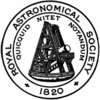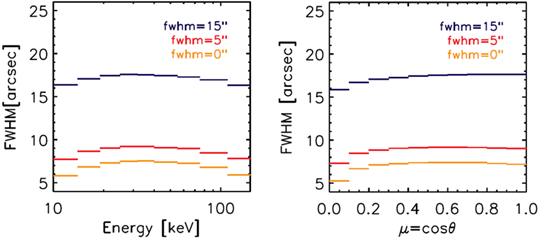Albedo and the modification of RHESSI results
From RHESSI Wiki
| Nugget | |
|---|---|
| Number: | 130 |
| 1st Author: | Natasha Jeffrey |
| 2nd Author: | Eduard Kontar |
| Published: | 29 June 2010 |
| Next Nugget: | Cloudy SolarSoftware |
| Previous Nugget: | Kernels and Ribbons |
| List all | |
Contents |
The albedo effect and our new simulations
Hard X-ray (HXR) photons produced by bremsstrahlung interactions in the solar chromosphere are not all going to be conveniently directed towards RHESSI. Some of the photons may first scatter in the denser photospheric layers before emerging. These are known as the "albedo" photons (Nugget #119,Nugget #42), and when viewed together with the directly emitted photons they can obscure the true properties of the HXR source in certain energy ranges. The albedo photons can increase the total flux, and also alter the source shape and apparent position. Note that hard X-ray albedo differs from the usual astronomical kind of albedo, since the Compton scattering producing the hard X-ray albedo also noticeably shifts the photon energies downward.
X-ray albedo is a well-studied phenomenon, interesting not only for the Sun but also for astronomical X-ray sources. The most important early study for the solar case was produced by T. Bai and R. Ramaty in 1978 [1]. Using Monte Carlo simulations, Bai and Ramaty re-created the process of hard X-ray scattering in the solar photosphere. Their simulations concluded that anisotropic HXR sources could be dominated by their albedo photons, with the albedo component producing changes to the measured spectrum, intensity and polarisation. At this early date (prior to the Reuven Ramaty High-Energy Solar Spectroscopic Imager) Bai and Ramaty could not actually measure HXR source position and size modifications due to the albedo effect.
RHESSI’s imaging capabilities, using for example the visibility forward fitting technique, can reliably measure properties such as source position and size using moments of the X-ray image. The zeroth moment is just the total X-ray flux, while the first (mean) and second (variance) moments provide us with the source (x,y) centroid position and size (FWHM) respectively. Measurements such as these have fuelled renewed attention in the importance of the albedo component and our new simulations have focused on finding actual source size increases and shifts in position due to the albedo photons.
Results from the simulations
Our simulations [2] examine how the albedo photons alter the properties of the HXR source, most importantly its size and position (measured using the 1st and 2nd moments of the distribution, just as with RHESSI visibility forward fitting). These changes were inspected for different positions (heliocentric angles) on the solar disk and for photon energies between 3 and 300 keV, typical observational HXR energy ranges for RHESSI. The results from all the simulations showed a general trend for both the measured source sizes and the shifts from the true source position. Generally the largest source increases due to albedo are observed nearer the solar centre (with limb sources least affected by the albedo photons) or at photon energies between 20-50 keV. The largest shifts in source position seem to occur again at energies between 20-50 keV and at mid-heliocentric angles with the measured position nearing its true position both at the solar centre and near the solar limb. For a source modelled as a disk 5” in diameter, Figure 1 depicts the increase in size and the shift in position due to the albedo component at an energy range of 20-50 keV. The red ellipse is the combined source that would be observed by an instrument such as RHESSI, while the black and blue ellipses represent the true HXR source and the scattered albedo component respectively. Shifts for a 5’’ source emitting isotropically, the shift can be as large as 0.4’’ at the peak heliocentric angles. The isotropic emitter sets a lower limit, and we would expect downward-beamed anisotropic sources to generally show an even greater shift from the true source position.

HXR sources with varying photon spectral indices, source sizes and anisotropies were also tried in our simulations.
Source spectral index: The lower the spectral index of the photon distribution (ie, the harder the spectrum), the greater the source size increase and position shift over all disk positions and photon energies, compared with similar HXR sources with larger spectral indices. In Figure 1, the original model photon distribution had a spectral index of 3.
Source size: We have observed that the smaller the true HXR source size, the greater the relative increase due to the albedo photons. An HXR point source may be observed as a source as large as 7’’ across when located near the solar centre or viewed at a peak energy range of 20-50 keV, whereas Figure 2 below shows that very large HXR sources show a much smaller relative increase due to the albedo photons, both in energy and location on the solar disk. The position shifts seem to be generally independent of source size if all other factors remain the same.
Source anisotropy: The contribution from the albedo component depends greatly on the anisotropy of the HXR source. If the HXR source initially throws more photons into the photosphere than towards RHESSI then the albedo component can be very large compared to the true direct component. Large downward directivities from isotropic sources can produce shifts as large as 0.8 arc sec.
Conclusions
Nearly all sources, including isotropic, are contaminated by albedo photons with even limb sources showing small changes in size and position. Our simulations are putting a strong case forward for the need for correction before size and position measurements are sought using RHESSI algorithms. Recent visibility forward fitting results have shown that RHESSI can produce (x,y) centroid positions with errors less than 0.5’’ but if the majority of the photons are narrowly directed towards the photosphere then we may see position shifts of 0.8’’ and some initial results using photon distributions simulated from a parent electron distribution have shown shifts may be greater than 1’’. Incorrect size and position measurements from RHESSI will ultimately lead to incorrect conclusions regarding the form and properties of the spatial distribution of the electrons. Separating, not removing the albedo component of the source is essential since it will also provide us with valuable information regarding the photons emitted towards the solar surface.
 This work was financially supported by the Royal Astronomical Society.
This work was financially supported by the Royal Astronomical Society.
References
- [1] Backscatter, anisotropy and polarization of solar hard X-rays
- [2] Positions and sizes of X-ray solar flare sources
| RHESSI Nugget Date | 29 June 2010 + |
| RHESSI Nugget First Author | Natasha Jeffrey + |
| RHESSI Nugget Index | 130 + |
| RHESSI Nugget Second Author | Eduard Kontar + |
